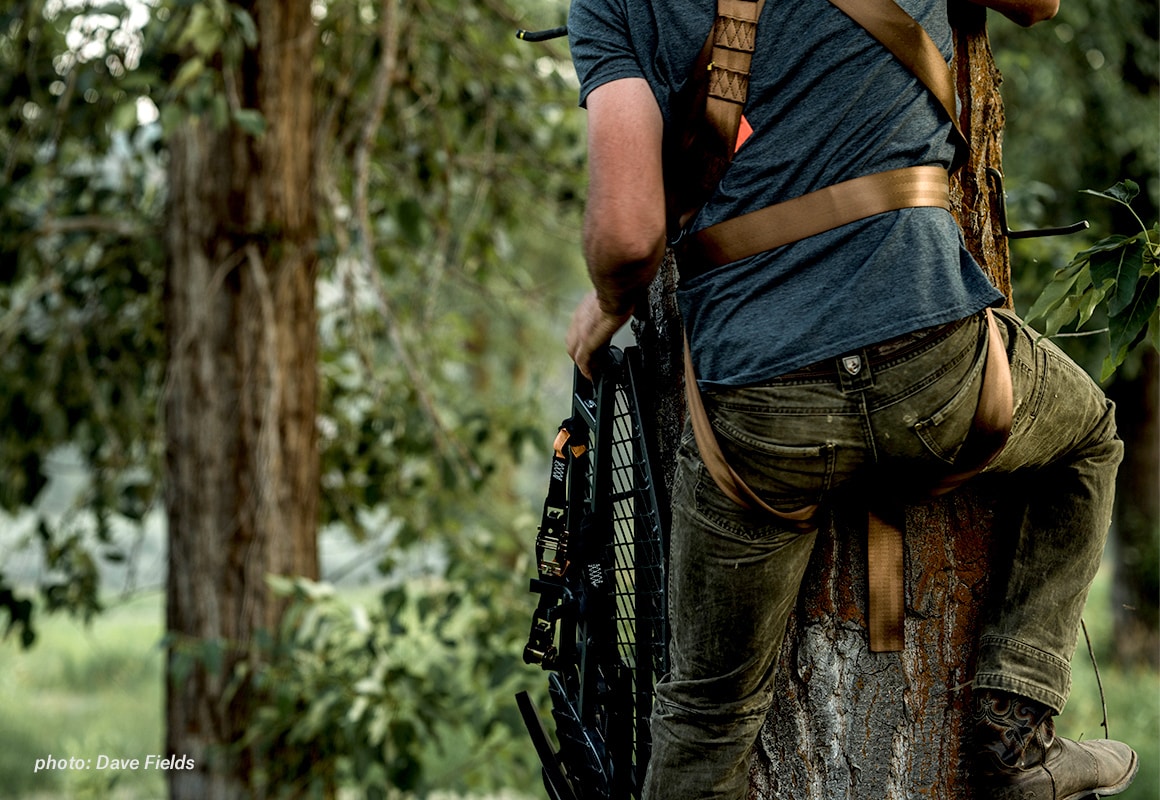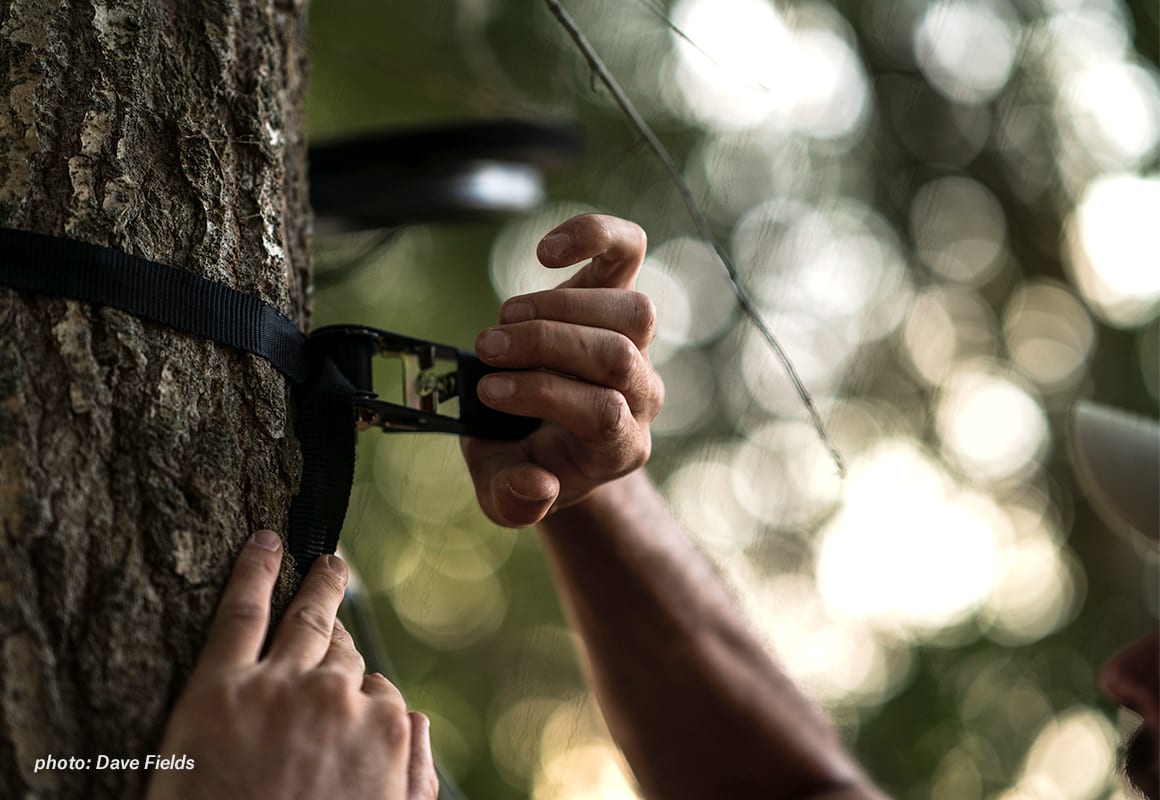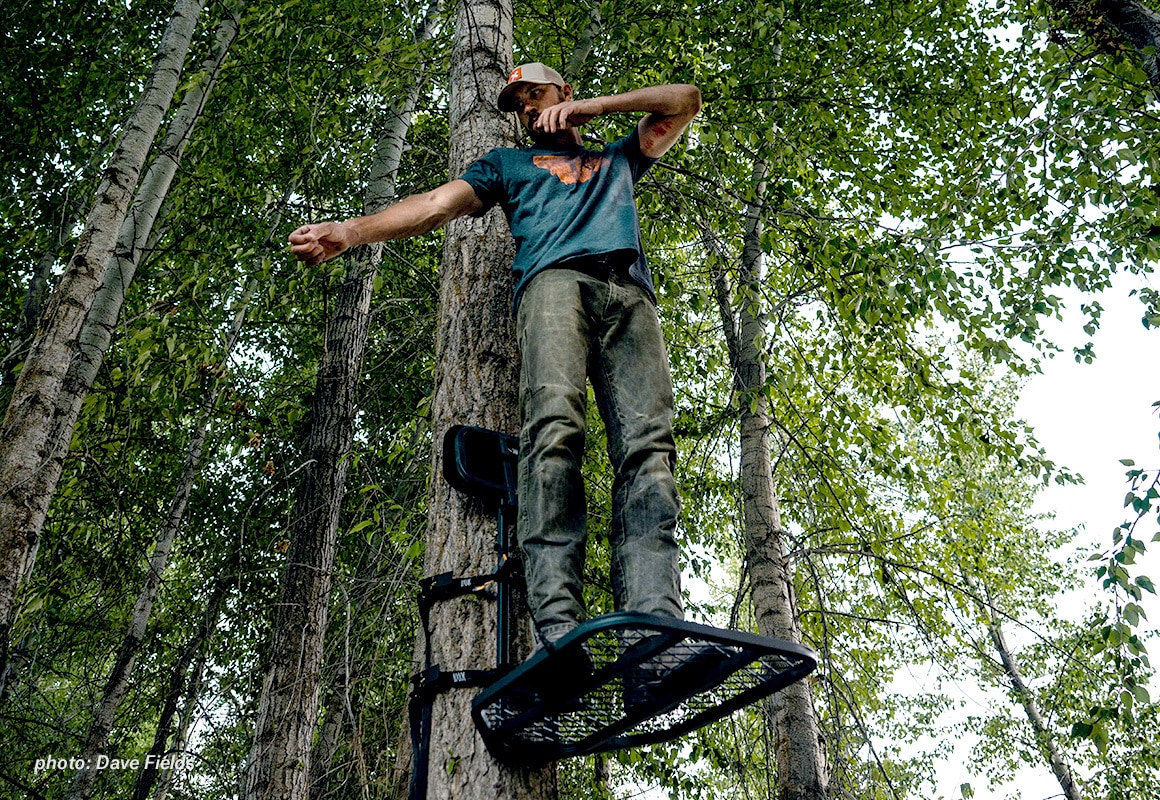Tree stand selection, placement, set-up and safety all factor into a successful hunt—and each aspect is a never-ending topic of discussion. Everyone has their own opinions on placement, hanging tactics, concealment and even the tree stand itself. While tree stand hunting is a personal decision, there are a few basic principles that can increase a hunter’s odds of seeing deer, having a good shot and make the entire process far more comfortable—and safe.
Portable tree stands come in three main categories, each suited to different uses and hunter preferences. Hang-on stands, the most basic, are simple stands that must be manually moved into place and secured carefully. Just like the name suggests, self-climbing stands allow a hunter to “walk” the stand up a tree and are best-suited to smooth trees with no branches between the hunter and the ground. Ladder stands look like a combined ladder and tree stand, and can be used on a wide range of trees but are often more conspicuous. Of the three options, hang-on stands are the most commonly used.
We covered tree stand placement thoroughly in our recent post How to Hunt Whitetail Deer Using the onX Hunt App, including sitting food, water, cover and seclusion. We also showed how best to enter and exit your stand without disturbing nearby deer and ruining that shot you’ve been waiting for all season. During the summer months, consider clearing multiple trails into your stand so you can walk in based upon deer feeding habits, wind direction and time of day, and mark these trails on the onX Hunt App.

onX Ambassador Steve Tittsworth knows that in his home state of Tennessee, tree stand placement is the most important part of the hunting puzzle. “Over the course of many years, our deer have learned to look up,” Tittsworth shares. “Once I have determined where I need my stand relative to the deer I’m hunting, I look for cover while looking up myself. Be it 30 feet high or only eight feet high, if that perfect tree is a white oak, hickory or hemlock, I’m looking up for the spot that a deer can’t see. Many times I’ve put a set at only eight feet off the ground in a leafed limb cluster and watched deer look right over top of me. I also set these up so I’m completely covered while the deer is directly under me and my opening comes as the deer is passing me. This ensures he’s looking away and the shot is never quartering to me. Higher is not always the best answer.”
onX Community Engagement Specialist Jared Larsen spent his fair share of time in tree stands while growing up hunting both Wisconsin and Iowa. And after years of hunting out of tree stands, he’s finessed his stand maintenance and set-up for maximum safety and comfort. He recommends:
• Oiling moving / connecting parts in the off-season to eliminate creaking in the cold.
• Adding felt tape between metal parts that touch and move (i.e a metal seat that you can fold up when you stand and fold down to sit—where it folds down, tape with felt to eliminate the metal-to-metal contact).
• If you have large feet, invest in a stand with an oversized platform (small platforms are a common issue with ladder stands).
• If you choose to leave your stand up year-round, remove your foam seating pads; otherwise the foam becomes a favored food for mice and squirrels.
• A screw-in bow holder for warmer hands and far more comfortable sits.
Once ensconced in your tree stand, ensure that you place your gear in easy-to-access locations. The last thing you want to be doing when the time comes is scrabbling for binos or rangefinders—a bit of advance planning can keep things calm, cool and collected and ensure you’re not spooking that mature buck that’s finally decided to make an appearance.

Tree stand security is a significant problem in some regions. Consider placing your tree stand away from heavily-used trails in locations where it’s harder to spot (then add a Waypoint in your onX App so you can find it easily, and share with friends if needed). Secure your stand with a highly-visible lock (a log chain or cable lock works well)—often a would-be thief will be deterred simply by seeing a lock. You can also remove the bottom of the ladder, tree steps or climbing sticks, making the tree stand not readily accessible.
Aaron Warbritton, host of the Hunting Public and onX Ambassador, has a few tricks of his own for tree stand hunting in the Midwest. “I use a lineman’s rope to hang the stand. It allows me to safely lean away from the tree and use both hands to set the stand up, making for a much quicker and safer setup,” he shares.
He adds: “Before I leave the ground, I’ll also tie one end of a 30-foot rope to my waist. The other end I tie to my gear (bow, pack, etc.) so I can pull it all up once in the stand. I also use milkweed pods as wind checkers. The seeds float for a long distance so you can watch wind currents away from your stand, unlike powder which only tells you wind direction at your exact location.”

Tom Petry, onX Ambassador and co-owner of Become 1 TV, believes the details truly set apart serious tree stand hunters. He shared a few of his tips with us:
• When transporting stands to and from your location, be sure to keep all straps, chains, etc. secured to the stand. The sound of metal clanging on metal travels a long way and can spook your game before you get a look at it.
• Once hung, be sure to secure all straps, pull-up ropes and loose pieces so they aren’t blowing in the wind. Dangling straps increase your chance of being seen or heard even when you aren’t in the stand. Spook a mature buck once—even when you aren’t there—and they may change their route instantly.
• Always have at least two stand sets for your major hunting areas, and set up accordingly for your two most typical wind directions.
• Be sure that your access to and from the stand is well thought out. From noise to exposure, how stealthy is your approach?
• Choose a location that will provide a good backdrop, especially if it’s a location that you will hunt throughout the year.
• Always check ratchet straps before hanging a stand. If there is ever a doubt as to the integrity of a strap, throw it out and go buy a new one… it will be much cheaper than the hospital bills.
• Never think you are too cool for lifelines and safety harnesses. They will never be as uncomfortable as the result of falling out.
And don’t forget the creature comforts. If the weather is cold, bring along more layers than you think you’ll need—nothing saps body heat like sitting still in an exposed environment. Layer up, keep your head covered to save body heat and never underestimate the chilling power of a persistent breeze during a cool morning. (Or the hot, beating sun in the afternoon.) Even if it’s pleasant in town, weather in the woods tends to have a mind of its own.
Anyone who has spent time in a tree stand will tell you to bring snacks and entertainment. Snacks, hot coffee and something to burn the hours will go a long way once you’re settled in your tree stand and waiting for the deer to arrive to the area. Make sure wrappers are not crinkly and loud—if it sounds loud in your house, it’s going to sound even louder in the woods. Repackage food into quieter containers if necessary.
Basic tree stand safety—wearing a harness at all times, having a lifeline system on each stand, conducting regular maintenance and hanging your treestand at the appropriate height—all factors into your success in the field. Practice your movements of getting in and out of the tree stand and know your personal limits. With a bit of advance research and good, old-fashioned hard work, you can have your most productive hunting season to date.
header image: Dave Fields